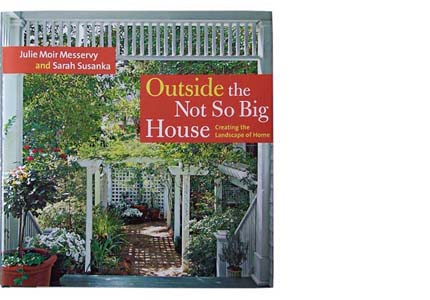

For current listings,
use our Property Search
or automated new listing notification –
RealtyWatcher.
Contents
If you have any questions or comments, don't hesitate to .

Readers of other books in the "Not So Big House" series are sure to enjoy this look inside twenty remarkable houses and yards. Sarah Susanka writes in a supporting role to garden designer Julie Moir Messervy, who takes us through home sites that exemplify landscapes for living, in sections titled, "Embracing the Habitat of Home," "Composing Journeys," "Linking the Inside with the Out," and "Crafting the Elements of Nature." Concepts for creating a yard as inviting and livable as its house are presented in photographs with informative captions, diagrams showing how a house relates to its site, along with engaging text and sidebars.
Examples include homes enlarged by their outward extension into their sites, as with extra-wide eaves that visually expand adjacent rooms. Columns, beams, and garden walls are finished to coordinate with the room they are viewed from, and hung with outdoor art. Natural materials for indoor rooms reflect garden plantings just outside. Decks framed at the corners echo rooms inside a house, with walls and ceilings of air and sky.
Windows are sited and shaped to compose a limited view like a photograph, or broadly glazed as transparent walls that reveal sweeping vistas. Distinctive clerestory windows heighten a room's sense of openness to the outdoors. Sources of natural light are added or enhanced in older homes without a loss of traditional style.
The authors mention "journeys" designed for residents and visitors, with features that provide guidance and inspiration. Gates, archways and trellised entries indicate varying levels of formality and mood. An entry path "instructs" visitors in the most elegant approach to a house. Circular and diagonal paving patterns define gathering places and decision points along a path. Layered gardens lure the viewer to transit gradually from the geometry and permanence of a patio to the soft, wild and indistinct environment at the edge of a property. Permeable fence alternatives define private space without a loss of neighborliness. Driveways and parking areas are beautified with attractive paving and garden elements.
The use of imaginative water concepts is shown. A drainage ditch is transformed into a rocky streambed. Indoor ponds and fountains visually integrate with outdoor water features. Dry ponds of stone, gravel, and plantings mimic many of the effects of a water pond.
Throughout the book, readers will find examples of unifying elements. A route through an entire site aligns and frames the visual field, or curves alluringly. Open, well-lighted spaces draw visitors forward through a passageway. Yard features relate to nearby public areas such as sidewalks and parks.
As with other books in the series, Outside the Not So Big House shows the wisdom of thinking beyond the static dimensions of home design, and considering time and movement as well. It's an easy book to flip through for inspiration, or read cover-to-cover to understand new ways of seeing outdoor living spaces, their access points, and their defining features, wherein gardening and gardens are united with the ongoing life of a home.
Return to Home by Design